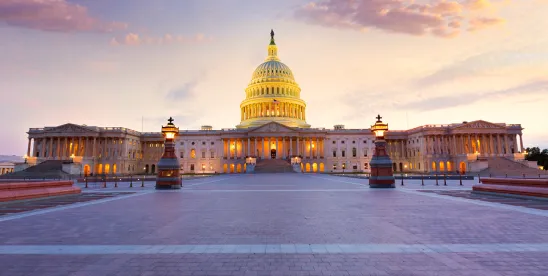8/10/2021 Update: On Tuesday morning, Aug. 10, the Senate passed its bipartisan infrastructure plan, H.R. 3684, by a 69-30 margin. A group of ten senators – nicknamed the “G10” and led by Sens. Kyrsten Sinema (D-AZ) and Rob Portman (R-OH) – were the drivers behind this infrastructure framework. Next, the Senate will work through the reconciliation process for a $3.5 trillion budget resolution. When they are back in session later this month or early next, the House plans to act on both the infrastructure bill and the budget resolution.
The Bipartisan Infrastructure Investment and Jobs Act of 2021 comes as an alternative to reauthorizing the Fixing America’s Surface Transportation (FAST) Act, which is set to expire at the end of September. It also incorporates key pieces of the Biden Administration’s domestic policy agenda. This 2,702-page bill - written across the aisle and being offered as a Senate amendment to H.R. 3684 - provides approximately $550 billion in new infrastructure spending over the next five years for surface transportation, including roads, bridges, rail, public transit, and airports; broadband; resiliency; water infrastructure, including for waste water and drinking water, and ports and waterways; and modernization, including low-carbon programs, electric vehicle charging, connecting communities, and addressing pollution. You can read the full bill text here.
It is anticipated that this package will pass the Senate sometime this coming weekend, however, its fate in the House of Representatives is unclear. This package has been tethered to President Biden’s “human infrastructure” plan, which House and Senate Democrats anticipate to pass via the budget reconciliation process to overcome Senate Republican opposition. The process on the budget reconciliation bill will begin next week as soon as the Senate dispenses with the Bipartisan Infrastructure Investment and Jobs Act of 2021.
Among other provisions, this package:
- Incorporates four bipartisan bills: (1) the Surface Transportation Reauthorization Act of 2021, (2) the Surface Transportation Investment Act, (3) the Drinking Water and Wastewater Infrastructure Act, and (4) the Energy Infrastructure Act. The Surface Transportation Reauthorization Act passed out of the Senate Committee on Environment and Public Works and the Surface Transportation Investment Act passed out of the Senate Committee on Commerce, Science and Transportation, both with bipartisan support.
- Seeks to encourage domestic manufacturing and procurement of materials for public works projects, with the intent to also create more domestic jobs throughout the product supply chain. “Build America, Buy America” ensures that American taxpayer dollars are spent on American-made iron, steel, and manufactured products.
- Appropriates for:
- Surface Transportation Infrastructure:
- $36B for Federal-State Partnership for Intercity Passenger Rail Grants
- $27.5B to the Federal Highway Administration for bride repair and improvement
- $16B for Amtrak’s National Network and $6 billion for Amtrak’s Northeast Corridor Network
- $15B for Airport Infrastructure grants
- $9.2B for the Bridge Investment Program
- $12.5B for National Infrastructure Investments grants
- $8B for the Federal Transit Administration’s Capital Investment Grants
- $5B for a National Electric Vehicle Formula Program
- $5B for an Airport Terminal Program
- Drinking Water/Wastewater Infrastructure:
- $10B to address per- and polyflouroalkyl (PFAS) substances
- $5B for FEMA’s flood mitigation and pre-disaster mitigation programs
- $618M for the Department of Agriculture’s NRCS Watershed program
- $75Mfor a WIFIA program to improve dams
- $8.3B for the Bureau of Reclamation’s water and related resources projects
- $15B to the Drinking Water State Revolving Fund program
- Broadband Infrastructure:
- $42.5B for the Broadband Equity, Access, and Deployment Program
- $2B for the Rural Utilities Service distance learning, telemedicine, and broadband program
- $2.8B for Digital Equity
- $1B for middle mile deployment, among other provisions
- Energy Infrastructure within Department of Energy:
- $16.2B for energy efficiency and renewably energy
- $7.4B for fossil energy and carbon management
- $2.1B for Carbon Dioxide Transportation Infrastructure Finance and Innovation Program
- $21.4B for Office of Clean Energy Demonstrations
- Environmental Infrastructure:
- $4.6B for an Energy Community Revitalization program
- $696M for Forest Service wildfire management
- $3.4B for ecosystem restoration programs at the EPA, FWS, and NOAA
- Surface Transportation Infrastructure:
- Offsets some of the spending with “Pay Fors”, including but not limited to:
- $50B in re-appropriated, previously unused funding from 2020 COVID-19 bills
- $50B in unused savings from the COVID-19 employer retention tax credit
- $105B in unused savings from COVID-19 Paid and Family Leave tax credits
- $51B from delaying the Medicare Part D drug rebate rule
- $28B from requiring cryptocurrency asset reporting to the IRS
- $21B from extending feeds on Government-Sponsored Enterprises (GSEs)
- Does not raise taxes. The goal is for economic growth as a result of efficiency, less costly infrastructure, and more productive workers.
- Preserves the 90/10 split of federal highway aid to states, but does not address the user fee for the Highway Trust Fund.
- Creates the Advanced Research Projects Agency-Infrastructure (“ARPA-I”) to fund research aimed at improving core infrastructure through innovation and new technology.
- Requires federal contracts for the domestic production of personal protective equipment (PPE) to last at least two years.
- Has widespread bipartisan support from 100+ associations and organizations like the AFL-CIO, U.S. Chamber of Commerce, National Governors Association, Small Business Roundtable, and National Association of Manufacturers.
- Will add a projected $256 billion to the federal budget deficit over the 2021-2031 period, according to the Congressional Budget Office (CBO). This score, which was released August 5, is key information for members deciding whether or not to vote in favor of the amendment to the bill.





 />i
/>i

